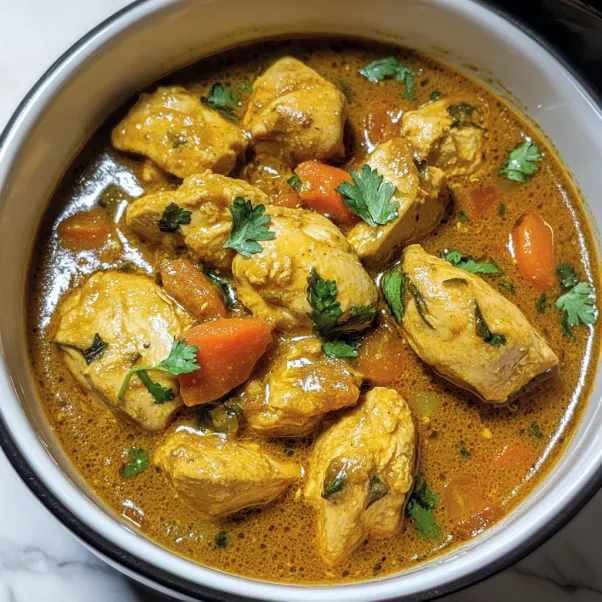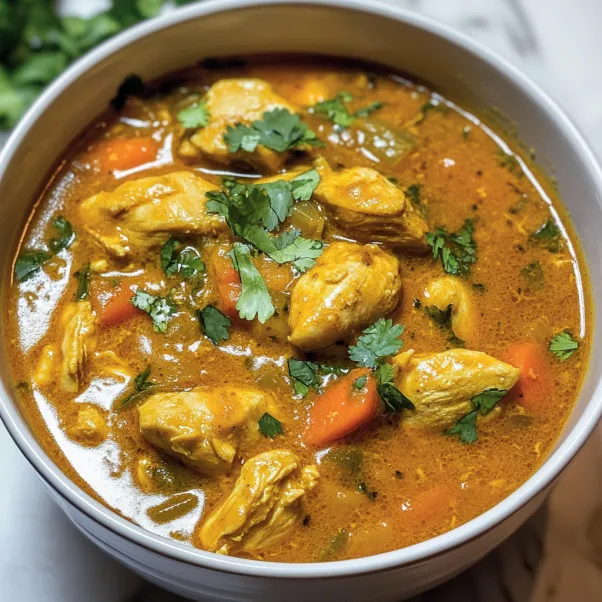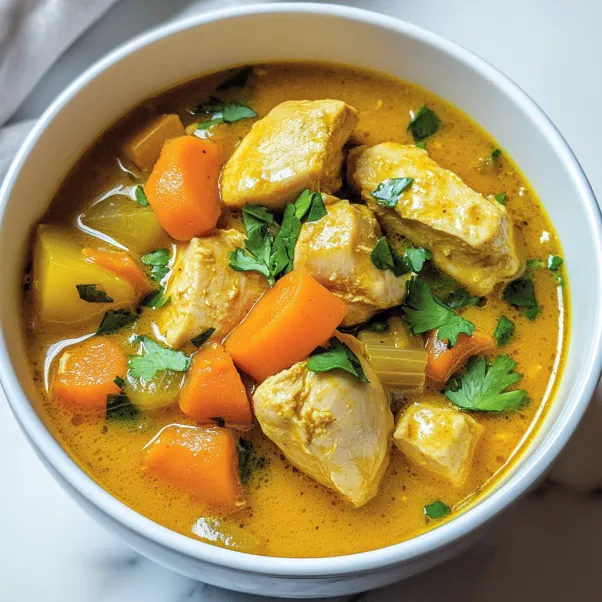 Save
Save
This crockpot yellow chicken curry has transformed my weeknight dinner routine, offering a hands-off approach to creating restaurant-quality curry at home. The slow cooking process allows the warm spices to infuse deeply into the tender chicken and vegetables, creating layers of flavor that taste like they took hours of active cooking.
I discovered this recipe during a particularly hectic month when I needed nourishing meals with minimal effort. The aroma that filled my home as it cooked transported me to my favorite Thai restaurant, but with the satisfaction of knowing exactly what went into the dish.
Ingredients
- Boneless skinless chicken thighs provide more flavor and moisture than breast meat and won't dry out during long cooking
- Yellow curry powder creates the signature color and flavor base look for one without fillers or salt added
- Fresh ginger adds bright zingy notes that balance the rich curry always choose firm pieces with smooth skin
- Potatoes and carrots add hearty substance and natural sweetness choose waxy potatoes that hold their shape
- Greek yogurt or coconut milk stirred in at the end creates luxurious creaminess without splitting
- Fresh cilantro and lime for garnish bring essential brightness to balance the rich curry
Step-by-Step Instructions
- Layer the Foundation
- Add chicken pieces to the bottom of your crockpot, ensuring they're cut into even bite-sized chunks for consistent cooking. Scatter the diced onion, minced garlic, and grated ginger over the chicken, creating an aromatic base that will infuse throughout the dish as it cooks.
- Build the Vegetable Layer
- Add the diced potatoes and sliced carrots on top of the aromatics. Keep the vegetable pieces roughly the same size about 1-inch chunks to ensure everything cooks at the same rate and reaches perfect tenderness simultaneously.
- Season with Intention
- Sprinkle all the spices curry powder, turmeric, cumin, coriander, optional cayenne, and salt evenly over the ingredients. The careful distribution ensures no single bite is overspiced while others lack flavor. Pour chicken broth over everything, using just enough to create steam without making the curry watery.
- Set and Forget
- Cover and set your crockpot to low for 6-7 hours if you're starting in the morning, or high for 3-4 hours if beginning later in the day. Resist the urge to lift the lid during cooking as this releases essential heat and extends cooking time.
- Create Creamy Richness
- About 20 minutes before serving, gently stir in the Greek yogurt or coconut milk. The temperature will have dropped just enough to prevent curdling, while still being hot enough to warm the dairy through. This late addition preserves the bright, creamy flavor that would otherwise dull during long cooking.
 Save
Save
Yellow curry powder has become my secret ingredient for countless dishes beyond this recipe. I keep it in a special jar near my stove, reaching for it whenever a dish needs depth without heat. The first time I served this curry, my skeptical father-in-law who claims to dislike "exotic" foods requested the recipe before dinner was even finished.
The Magic of Low and Slow
The crockpot method allows the spices to bloom gradually and infuse deeply into the chicken and vegetables. Unlike stovetop curries where you might rush the process, this slow-cooked version develops complex flavors through time rather than technique. The gentle, consistent heat breaks down the chicken's connective tissues without drying out the meat, resulting in pieces that practically melt in your mouth.
Smart Substitutions
This recipe welcomes adaptation based on what you have available. Sweet potatoes can replace regular potatoes for added nutrition and natural sweetness. Butternut squash works beautifully as a lower-carb alternative to potatoes. If you prefer a vegetarian version, replace the chicken with 2 cans of drained chickpeas and vegetable broth instead of chicken broth. For dairy sensitivities, coconut milk creates an equally delicious result with a slightly sweeter profile than yogurt.
Serving Suggestions
While traditional basmati rice makes an excellent base for soaking up the flavorful sauce, this curry pairs beautifully with many alternatives. Try serving over cauliflower rice for a lower-carb option, or with warm naan bread for scooping up every last bit of sauce. A side of quick-pickled cucumbers provides refreshing contrast to the warm spices. For entertaining, set up a toppings bar with fresh cilantro, sliced jalapeños, chopped peanuts, and lime wedges so guests can customize their bowls.
 Save
Save
Common Recipe Questions
- → Can I use chicken breasts instead of thighs?
Yes, both boneless skinless chicken breasts or thighs work well in this curry. Thighs tend to stay more tender during long cooking, but breasts are perfectly fine if you prefer leaner meat. Just ensure you cut them into even bite-sized pieces for consistent cooking.
- → Why add the yogurt or coconut milk at the end?
Adding dairy or coconut milk at the end prevents it from splitting during the long cooking process. This 20-minute finishing step ensures a smooth, creamy texture rather than a grainy or curdled sauce.
- → Can I make this curry spicier?
Absolutely! Adjust the heat by increasing the cayenne pepper or adding fresh chilies. You can also stir in some red pepper flakes or a dash of hot sauce at the end to customize the spice level to your preference.
- → What vegetables can I substitute in this curry?
This curry is versatile—try sweet potatoes, cauliflower, bell peppers, peas, or spinach (add leafy greens in the last 30 minutes). The key is cutting firmer vegetables into similar-sized pieces so they cook evenly.
- → How can I store and reheat leftovers?
Store cooled leftovers in an airtight container in the refrigerator for up to 3 days. Reheat gently on the stovetop or microwave until just hot. The flavors often deepen overnight, making this curry even better the next day.
- → Can I freeze this curry?
Yes, freeze in airtight containers for up to 3 months. For best results, freeze before adding the yogurt/coconut milk, then add fresh dairy when reheating. If already mixed, it will still freeze well but may have slight texture changes upon thawing.
